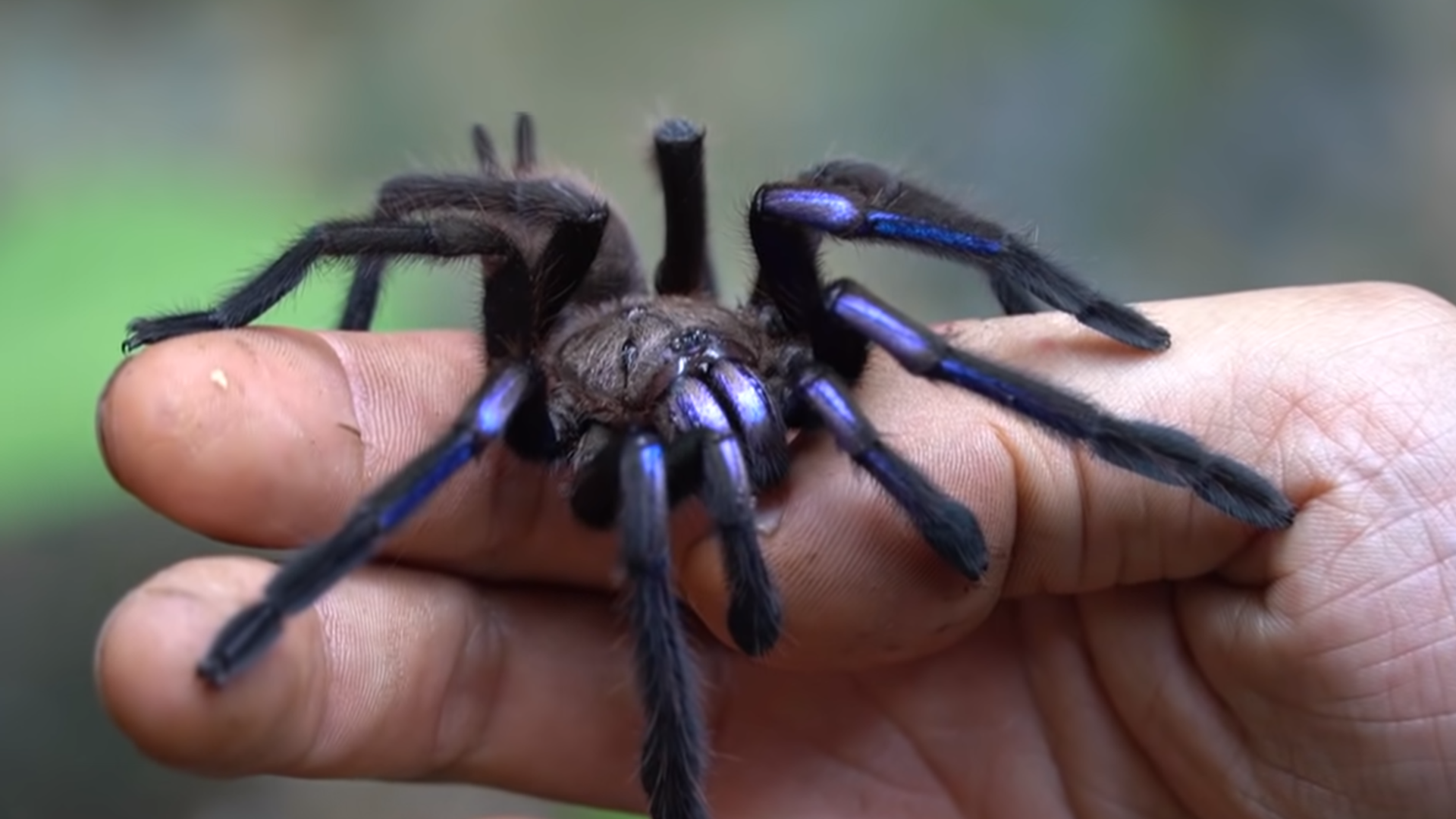https://sputnikglobe.com/20230926/scientists-find-home-of-collector-favorite-electric-blue-tarantula-in-thailands-mangroves-1113704265.html
Scientists Find Home of Collector Favorite ‘Electric Blue’ Tarantula in Thailand’s Mangroves
Scientists Find Home of Collector Favorite ‘Electric Blue’ Tarantula in Thailand’s Mangroves
Sputnik International
Scientists have found the natural home of the so-called Electric Blue Tarantula. The species has long been beloved by collectors of exotic species, but its natural environment was not previously known to science.
2023-09-26T21:20+0000
2023-09-26T21:20+0000
2023-09-26T21:18+0000
beyond politics
tarantula
thailand
spider
https://cdn1.img.sputnikglobe.com/img/07e7/09/1a/1113704393_0:69:2368:1401_1920x0_80_0_0_82561ef6bad83fe13dda074f741ec772.png
The species has now been given a Latin scientific name, Chilobrachys natanicharum, placing it in the genus of other tarantulas from southern and eastern Asia. The name was chosen after an auction campaign, with all proceeds from the auction donated to support the education of children in Thailand’s Lahu communities and to poor cancer patients. According to media reports, the species name natanicharum is a combination of the names of two wealthy patrons from the firm that placed the winning bet.Electric Blue makes its home in the watery mangrove forests of Thailand, the first tarantula ever found to live in that environment. The scientists, based out of Khon Kaen University in northeastern Thailand, said they knew where to look for the tarantula’s home after a similar species was found last year among Thailand’s bamboo forests - also a first for the genus."These tarantulas inhabit hollow trees, and the difficulty of catching an electric-blue tarantula lies in the need to climb a tree and lure it out of a complex of hollows amid humid and slippery conditions. During our expedition, we walked in the evening and at night during low tide, managing to collect only two of them."Mangrove forests are an important feature of ecology in the riverine country, which celebrates National Mangrove Forests Day on May 10 of each year. Their dense network of roots creates rich biodiversity and the plants are highly effective sequesterers of carbon dioxide, the gas that is pumped out by human civilization in quantities large enough to trigger changes in the planet’s climate.There’s much the scientists still don’t know about the Electric Blue, such as why it has such a striking appearance. Blue is among the rarest colors found in nature, especially a shimmering metallic hue like on this tarantula, which could easily fall prey to big hunters like birds. However, it could play social roles in communication or courtship with other tarantulas of the same species.“These tarantulas can thrive in arboreal as well as terrestrial burrows in evergreen forests. However, when it comes to mangrove forests, their habitat is restricted to residing inside tree hollows due to the influence of tides," he added. "It's essential for the general public to understand the significance of taxonomy as a fundamental aspect of research. Taxonomy serves a vital role, ranging from the basic, such as when people inquire on social media about the name of a spider, to conducting crucial research aimed at preserving these species from extinction."A paper describing the scientists’ discovery was published in ZooKeys.
https://sputnikglobe.com/20200103/scary-beauty-sapphire-blue-tarantula-leaves-netizens-in-awe-1077929084.html
thailand
Sputnik International
feedback@sputniknews.com
+74956456601
MIA „Rossiya Segodnya“
2023
News
en_EN
Sputnik International
feedback@sputniknews.com
+74956456601
MIA „Rossiya Segodnya“
Sputnik International
feedback@sputniknews.com
+74956456601
MIA „Rossiya Segodnya“
electric blue tarantula; thailand; mangrove forest
electric blue tarantula; thailand; mangrove forest
Scientists Find Home of Collector Favorite ‘Electric Blue’ Tarantula in Thailand’s Mangroves
Scientists have found the natural home of the so-called 'Electric Blue Tarantula.' The species has long been beloved by collectors of exotic species, but its natural environment was not previously known to science and it had never been properly described by naturalists.
The species has now been given a Latin scientific name, Chilobrachys natanicharum, placing it in the genus of other tarantulas from southern and eastern Asia.
The name was chosen after an auction campaign, with all proceeds from the auction donated to support the education of children in Thailand’s Lahu communities and to poor cancer patients. According to media reports, the species name natanicharum is a combination of the names of two wealthy patrons from the firm that placed the winning bet.
Electric Blue makes its home in the watery mangrove forests of Thailand, the first tarantula ever found to live in that environment. The scientists, based out of Khon Kaen University in northeastern Thailand, said they knew where to look for the tarantula’s home after a similar species was found last year among Thailand’s bamboo forests - also a first for the genus.
"The first specimen we found was on a tree in the mangrove forest," explained arachnologist Narin Chomphuphuang, the study’s lead author, in a news release.
"These tarantulas inhabit hollow trees, and the difficulty of catching an electric-blue tarantula lies in the need to climb a tree and lure it out of a complex of hollows amid humid and slippery conditions. During our expedition, we walked in the evening and at night during low tide, managing to collect only two of them."

3 January 2020, 12:00 GMT
Mangrove forests are an important feature of ecology in the riverine country, which celebrates National Mangrove Forests Day on May 10 of each year. Their dense network of roots creates rich biodiversity and the plants are highly effective sequesterers of carbon dioxide, the gas that is pumped out by human civilization in quantities large enough to trigger changes in the planet’s climate.
There’s much the scientists still don’t know about the Electric Blue, such as why it has such a striking appearance. Blue is among the rarest colors found in nature, especially a shimmering metallic hue like on this tarantula, which could easily fall prey to big hunters like birds. However, it could play social roles in communication or courtship with other tarantulas of the same species.
"The Electric Blue Tarantula demonstrates remarkable adaptability,” Chomphuphuang said.
“These tarantulas can thrive in arboreal as well as terrestrial burrows in evergreen forests. However, when it comes to mangrove forests, their habitat is restricted to residing inside tree hollows due to the influence of tides," he added.
"It's essential for the general public to understand the significance of taxonomy as a fundamental aspect of research. Taxonomy serves a vital role, ranging from the basic, such as when people inquire on social media about the name of a spider, to conducting crucial research aimed at preserving these species from extinction."
A paper describing the scientists’ discovery was
published in ZooKeys.



